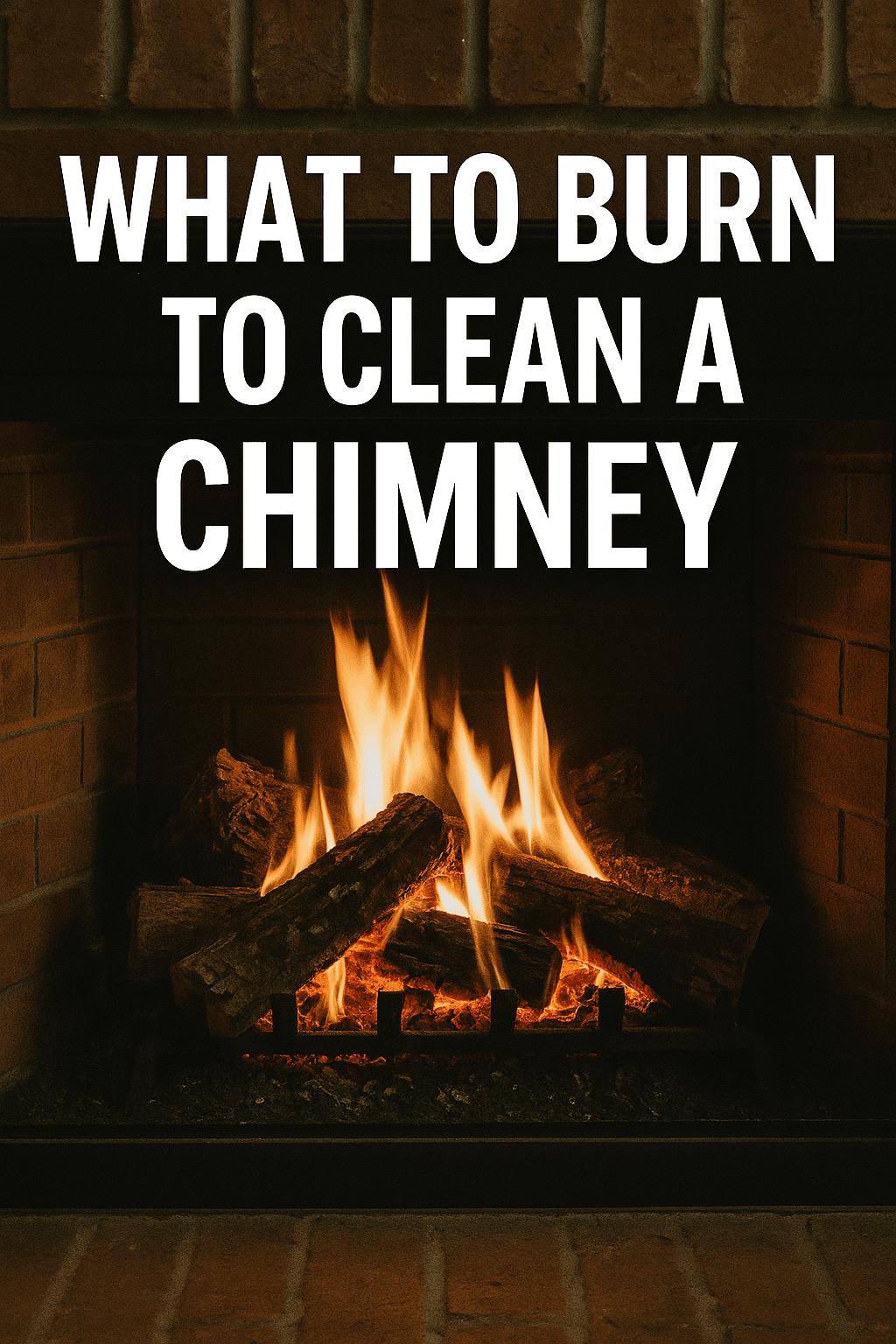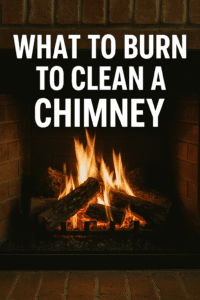What to Burn to Clean Your Chimney: A Certified Pro’s Guide (2025)
The crackle of a wood fire is one of life’s simple pleasures, offering warmth, comfort, and a captivating focal point for any room. But behind that cozy scene, a hidden danger can be building up in your chimney: **creosote**. This flammable byproduct of burning wood is the leading cause of chimney fires in the United States. It’s no wonder that homeowners are always looking for an easy way to keep their chimneys clean and safe.
This search often leads to a popular category of products: chimney sweeping logs. You’ve likely seen them in hardware stores, promising to clean your chimney as you enjoy a fire. But do they actually work? Can you really just burn a special log and consider your chimney clean? As a Chimney Safety Institute of America (CSIA) certified professional, I’m here to give you the unvarnished truth.
In this guide, we’ll break down the science of creosote, explain what cleaning logs do (and what they *don’t* do), and outline the best practices for burning wood to keep your chimney cleaner and your home safer all season long.

The #1 Enemy: Understanding the Three Stages of Creosote
Before you can understand how to “clean” your chimney by burning something, you need to know exactly what you’re up against. Creosote is not a single substance; it’s a complex mixture of unburned wood particles, tars, and moisture that condenses on the cool inner walls of your chimney. It progresses through three distinct stages, each more dangerous than the last.
Stage 1: Fluffy Soot
This is the earliest stage. It’s mostly black carbon dust with a velvety or flaky texture. Stage 1 creosote is the easiest to remove with a standard chimney brush and is typically the result of burning hot fires with well-seasoned wood.
Stage 2: Crunchy & Tar-Like
When fires are burned at cooler temperatures or with damp wood, the creosote becomes more substantial. It takes on a crunchy, porous, or tar-like appearance, often looking like black cornflakes. This type is harder to remove and significantly more flammable than Stage 1.
Stage 3: Glazed or “Third-Degree” Creosote
This is the most dangerous form. It looks like a thick, black, shiny layer of tar that has been baked onto the flue liner. It’s incredibly dense and hard. Stage 3 creosote is caused by consistently burning wet wood or running a wood stove at low temperatures for long periods. It cannot be removed with standard chimney brushes and often requires specialized tools or chemical treatments by a professional. It’s also the most likely type to ignite a chimney fire.
The Real Answer: How Chimney Sweeping Logs Work
Now that you understand creosote, let’s talk about the products designed to combat it: **Creosote Sweeping Logs (CSLs)**. These are not logs in the traditional sense; they are compressed logs made of sawdust and other materials, impregnated with a proprietary blend of chemical catalysts.
The Science Explained: It’s a Chemical Reaction
A CSL does not mechanically scrape or scrub your chimney. Instead, it works through a catalytic process. Here’s a step-by-step breakdown:
- Activation: You place the log on a bed of hot coals from a previous fire. As the log burns, the heat releases the active chemicals as a gas.
- Coating: This gas rises up the chimney and clings to the creosote deposits on the flue walls.
- Transformation: The catalysts in the gas then cause a chemical reaction within the creosote. This reaction breaks down the tarry, sticky bonds of the creosote, changing its chemical structure.
- Result: The dangerous, adhesive creosote (especially Stage 2) is transformed into a less-volatile, brittle, or ash-like substance. This modified creosote is much less likely to ignite and can be more easily removed.
Essentially, a CSL makes your chimney **safer in the short term and easier for a professional to clean later.**

Top Pick: CSL Creosote Sweeping Log
A leading and widely trusted brand, this Creosote Sweeping Log is an excellent tool for your regular chimney maintenance routine. Using one periodically during the burn season helps reduce the flammability of creosote buildup between professional cleanings.
Check Price on AmazonThe Crucial Limitations: What Cleaning Logs CANNOT Do
Understanding the limitations of these logs is just as important as knowing how they work. This is where a false sense of security can become dangerous.
- They CANNOT Remove Heavy Buildup: A CSL is ineffective against Stage 3 glazed creosote. It also cannot remove large, thick deposits of Stage 2 creosote. It only treats the surface.
- They CANNOT Remove Blockages: A professional sweep is also an inspection. They look for and remove blockages like animal nests, leaves, and debris. Burning a log will do nothing about these fire hazards. An annual inspection is vital to avoid issues like figuring out how to get a raccoon out of your chimney or dealing with the sad reality of how long for a bird stuck in chimney to die, which can create both a blockage and a terrible odor.
- They CANNOT Inspect Your Chimney’s Structure: A certified sweep performs a visual inspection (known as a Level 1 Inspection) to check for structural issues like cracked liners, damaged crowns, or deteriorating brickwork. These are serious safety issues that a log can’t diagnose. Identifying these early can save you thousands, and it’s important to know what the best mortar for chimney repairs is and whether your homeowners insurance covers chimney repair.
Prevention: How to Burn for a Cleaner Chimney
The best way to “clean” your chimney is to prevent creosote from forming in the first place. This comes down to two key principles: burning the right fuel and burning it at the right temperature.
1. The Gospel of Good Wood: Seasoned is a Must
The number one cause of creosote buildup is burning unseasoned or “green” wood. Freshly cut wood can be over 50% water by weight. When you burn it, a huge amount of energy is wasted boiling this water off, creating cool, steamy smoke that is perfect for producing creosote. **Properly seasoned firewood should have a moisture content below 20%.** The only way to know for sure is to test it.

Essential Tool: Digital Wood Moisture Meter
Take the guesswork out of seasoning. This simple tool instantly tells you the moisture content of your firewood. It’s the single best investment you can make to ensure cleaner, hotter, and safer fires. Aim for 15-20% for optimal burning.
Check Price on Amazon2. Burn It Hot!
A hot, roaring fire burns wood more completely, resulting in less smoke and less creosote. Smoldering, slow-burning fires are major creosote producers. Keep your fire burning briskly, especially for the first 30 minutes, to get the flue hot quickly. A stove thermometer can help you maintain the ideal temperature range.
3. What NEVER to Burn
Your fireplace is not an incinerator. Burning the wrong things can release toxic chemicals, damage your flue, and create huge amounts of soot. Never burn:
- Painted, treated, or pressure-treated wood
- Plywood, particleboard, or MDF
- Household trash or plastics
- Glossy paper or magazines
- Driftwood (contains salt, which is corrosive)
The Indispensable Role of a Professional Sweep
According to **NFPA 211**, the national safety standard, “Chimneys, fireplaces, and vents shall be inspected at least once a year.” This isn’t a suggestion; it’s the professional safety standard for a reason. A professional sweep provides:
- Guaranteed Removal: They use specialized brushes, rods, and powerful vacuums like the best chimney sweep vacuum systems to physically remove all stages of creosote.
- Expert Inspection: They are trained to spot problems you can’t see, from hairline cracks in flue tiles to issues with the exterior masonry and flashing. They’ll even check attachments on your chimney, ensuring things like the best chimney antenna mount are secure and not compromising the structure.
- Peace of Mind: Nothing beats the confidence of knowing your chimney system has been deemed safe by a certified expert.
Frequently Asked Questions (FAQ)
How often should I use a chimney cleaning log?
Most manufacturers recommend using one log for every 60 fires, or one or two logs over the course of a typical burning season. Follow the specific instructions on the product you purchase.
Can I use more than one log at once?
No. Never use more than one CSL at a time, and do not add it to a raging fire. Add it to a well-established bed of hot coals, as instructed.
Are the fumes from cleaning logs toxic?
When used correctly in a properly functioning chimney, the chemicals are vented safely outside. They are not intended to be inhaled, and you should not have smoke spilling into your room. If you do, it’s a sign of a blockage or draft problem that needs immediate professional attention.
What happens to the creosote after I use a log?
The treated, brittle creosote may fall into your smoke shelf or firebox over the next few days or weeks as you have subsequent fires. It’s important to be aware that this can happen. The majority of it will be removed during your next professional sweeping.
Conclusion: A Tool, Not a Silver Bullet
So, what should you burn to clean a chimney? The answer is a **Creosote Sweeping Log**, but only when used correctly as one part of a comprehensive safety strategy. Think of it like using a fuel injector cleaner in your car; it’s good maintenance, but it’s not a substitute for getting a real oil change and engine tune-up from a mechanic.
Embrace these logs as a helpful tool to make your fires safer throughout the winter. But never, ever let them replace the annual inspection and sweep from a certified professional. It’s the single most important thing you can do to protect your home and family. After all, you want your chimney to be clean and clear for the only visitor who’s supposed to use it, and we all have our theories about how does Santa get in without a chimney these days anyway!

